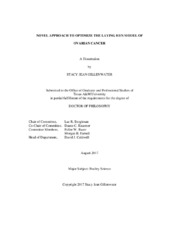| dc.description.abstract | No appreciable improvements in incidences and mortality rates of women with ovarian cancer have been made over the last 40 years; this fact alone indicates that scientists and clinicians lack the adequate tools to conquer this deadly disease. The American Cancer Society estimates that more than 22,000 women will be diagnosed with ovarian cancer this year, and over 14,000 deaths will be attributed to this disease; this translates to 1 out of every 75 women in the US being diagnosed with ovarian cancer, and of those diagnosed, over 60% will die from the disease. Lack of a more predictive animal model has been an obstacle to progress in ovarian cancer research. It is hypothesized that laying hens, though not fully characterized, could be an optimal animal model for the study of human ovarian cancer initiation, progression, therapy and relapse. Domestic laying hens (Gallus gallus domesticus), spontaneously develop ovarian cancer at a high incidence.
In an effort to better characterize ovarian cancer in laying hens, we created a surgically implantable, biocompatible port using 3D printing technology, which allows for repeated access to the ovary for laparoscopic serial sampling, observation, and imaging. With the ability to follow laying hens via easily accessible ports throughout their lifespan, our hope is to be able to detect when they develop ovarian cancer, as well as discover early diagnostic techniques for this disease.
The fact that laying hens are a spontaneous ovarian cancer model with a high incidence of disease suggests their usefulness as a preclinical animal model. Little is known about tolerability and efficacy of chemotherapeutics in the laying hen or in avian species in general. We administered a 6-week paclitaxel treatment to assess chemotherapeutic efficacy in 4.5-year-old laying hens suspect for ovarian cancer. Magnetic resonance imaging (MRI) and positron emission tomography–computed tomography (PET/CT) were used to identify cancerous laying hens as well as to assess changes in tumorigenesis throughout treatment. Results are indicative of chemotherapeutic tolerability and efficacy, as well as the value of using a non-invasive method for diagnosis of cancer within the coelomic cavity, further suggesting the potential of the laying hen as an animal model for preclinical research. | en |


